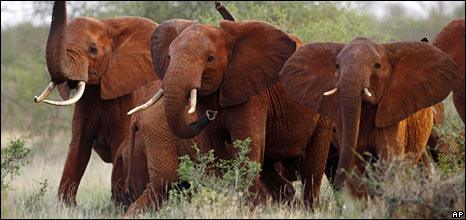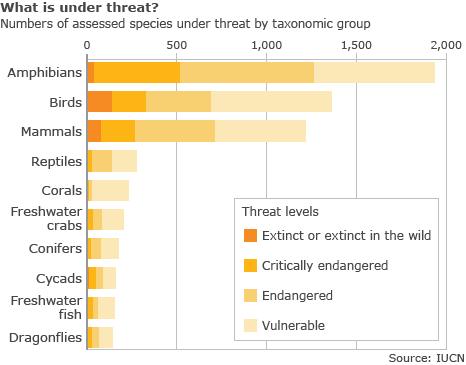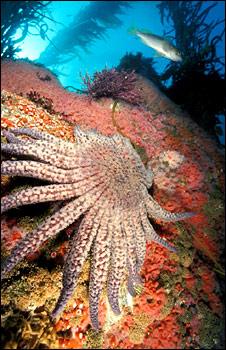Nature loss 'to damage economies'
- Published

The abundance of mammals, birds, reptiles and other creatures is falling rapidly
The Earth's ongoing nature losses may soon begin to hit national economies, a major UN report has warned.
The third Global Biodiversity Outlook (GBO-3) says that some ecosystems may soon reach "tipping points" where they rapidly become less useful to humanity.
Such tipping points could include rapid dieback of forest, algal takeover of watercourses and mass coral reef death.
Last month, scientists confirmed that governments would not meet their target of curbing biodiversity loss by 2010.
"The news is not good," said Ahmed Djoglaf, executive secretary of the UN Convention on Biological Diversity (CBD).
"We continue to lose biodiversity at a rate never before seen in history - extinction rates may be up to 1,000 times higher than the historical background rate."
The global abundance of vertebrates - the group that includes mammals, reptiles, birds, amphibians and fish - fell by about one-third between 1970 and 2006, the UN says.
Seeing red
The 2010 target of significantly curbing the global rate of biodiversity loss was agreed at the Johannesburg summit in 2002.
It has been clear for a while that it would not be met.
But GBO-3 concludes that none of the 21 subsidiary targets set at the same time are being met either, at least not on a global basis.
These include measures such as curbing the rate of habitat loss and degradation, protecting at least 10% of the Earth's ecological regions, controlling the spread of invasive species and making sure that international trade does not take any species towards extinction.
No government submitting reports to the convention on biodiversity group claims to have completely met the 2010 target.
While progress is being made in some regions, the global failure means an ever-growing number of species are on the Red List of Threatened Species.
"Twenty-one percent of all known mammals, 30% of all known amphibians, 12% of all known birds (and)... 27% of reef-building corals assessed... are threatened with extinction," said Bill Jackson, deputy director general of the International Union for the Conservation of Nature (IUCN), which maintains the Red List.
"If the world made equivalent losses in share prices, there would be a rapid response and widespread panic."

The relationship between nature loss and economic harm is much more than just figurative, the UN believes.
An ongoing project known as The Economics of Ecosystems and Biodiversity (TEEB) is attempting to quantify the monetary value of various services that nature provides for us.
These services include purifying water and air, protecting coasts from storms and maintaining wildlife for ecotourism.
The rationale is that when such services disappear or are degraded, they have to be replaced out of society's coffers.

Loss of coral reefs will reduce humanity's supply of seafood
TEEB has already calculated the annual loss of forests at $2-5 trillion, dwarfing costs of the banking crisis.
"Many economies remain blind to the huge value of the diversity of animals, plants and other lifeforms and their role in healthy and functioning ecosystems," said Achim Steiner, executive director of the UN Environment Programme (Unep).
"Humanity has fabricated the illusion that somehow we can get by without biodiversity, or that it is somehow peripheral to our contemporary world.
"The truth is we need it more than ever on a planet of six billion heading to over nine billion people by 2050."
The more that ecosystems become degraded, the UN says, the greater the risk that they will be pushed "over the edge" into a new stable state of much less utility to humankind.
For example, freshwater systems polluted with excess agricultural fertiliser will suffocate with algae, killing off fish and making water unfit for human consumption.
The launch of GBO-3 comes as governments begin two weeks of talks in Nairobi aimed at formulating new measures to tackle global biodiversity loss that can be adopted at October's Convention on Biological Diversity summit in Japan.
- Published29 April 2010